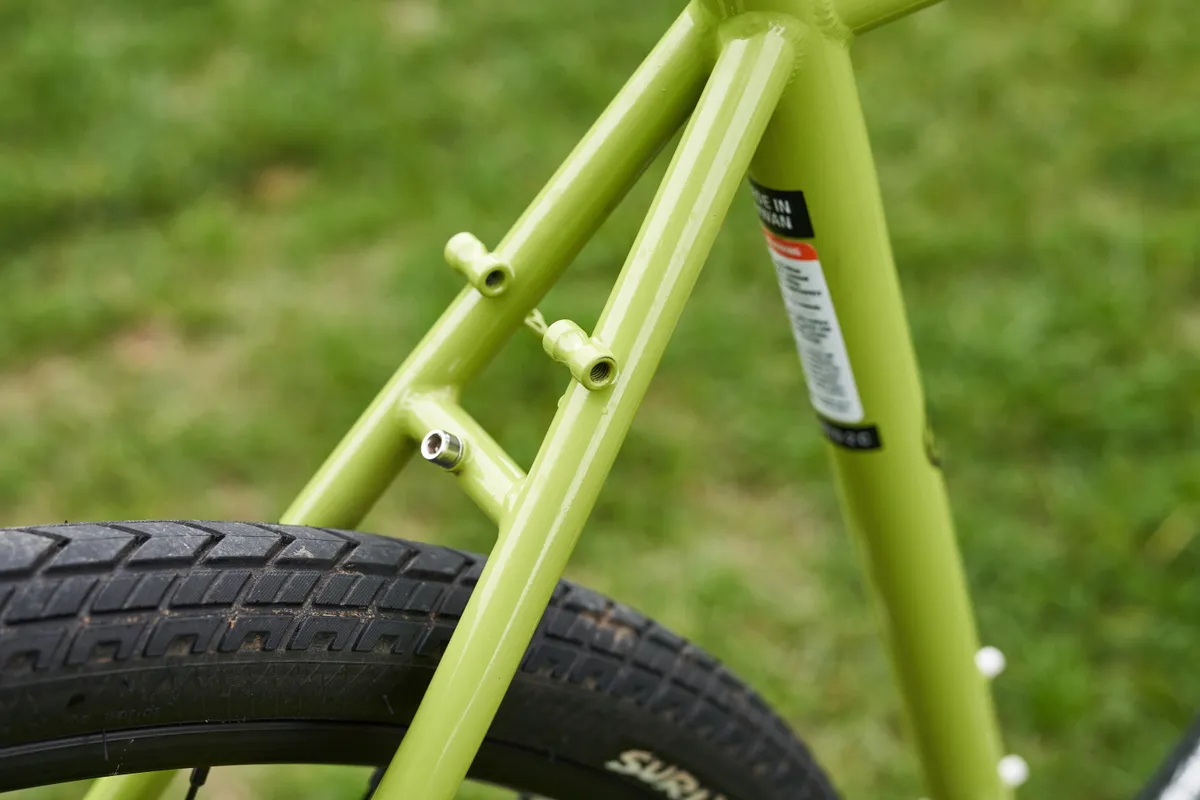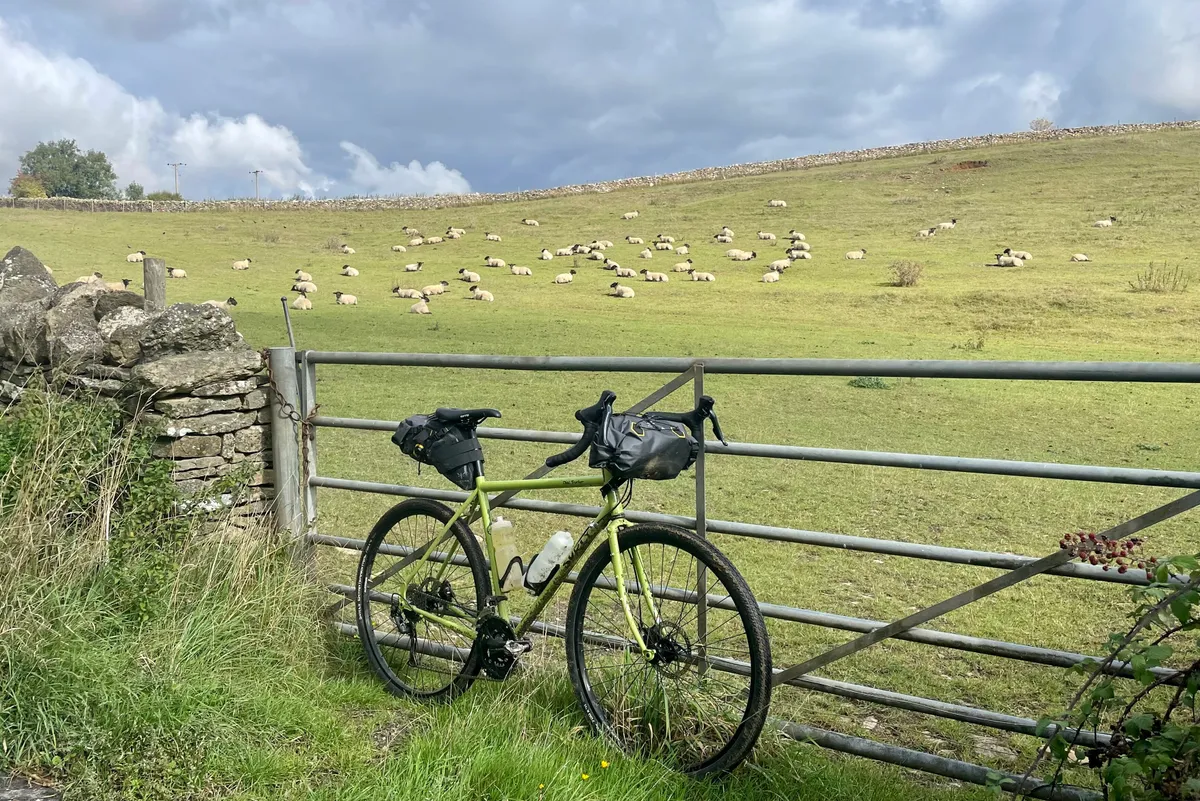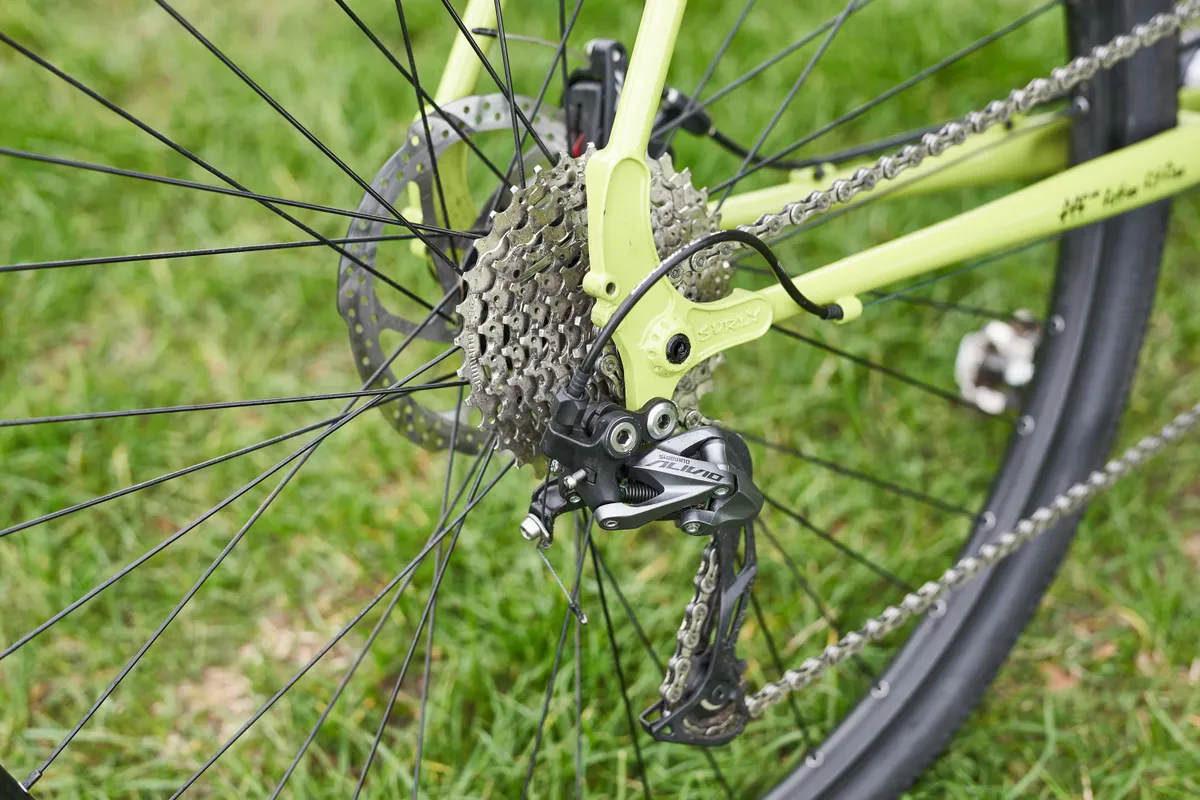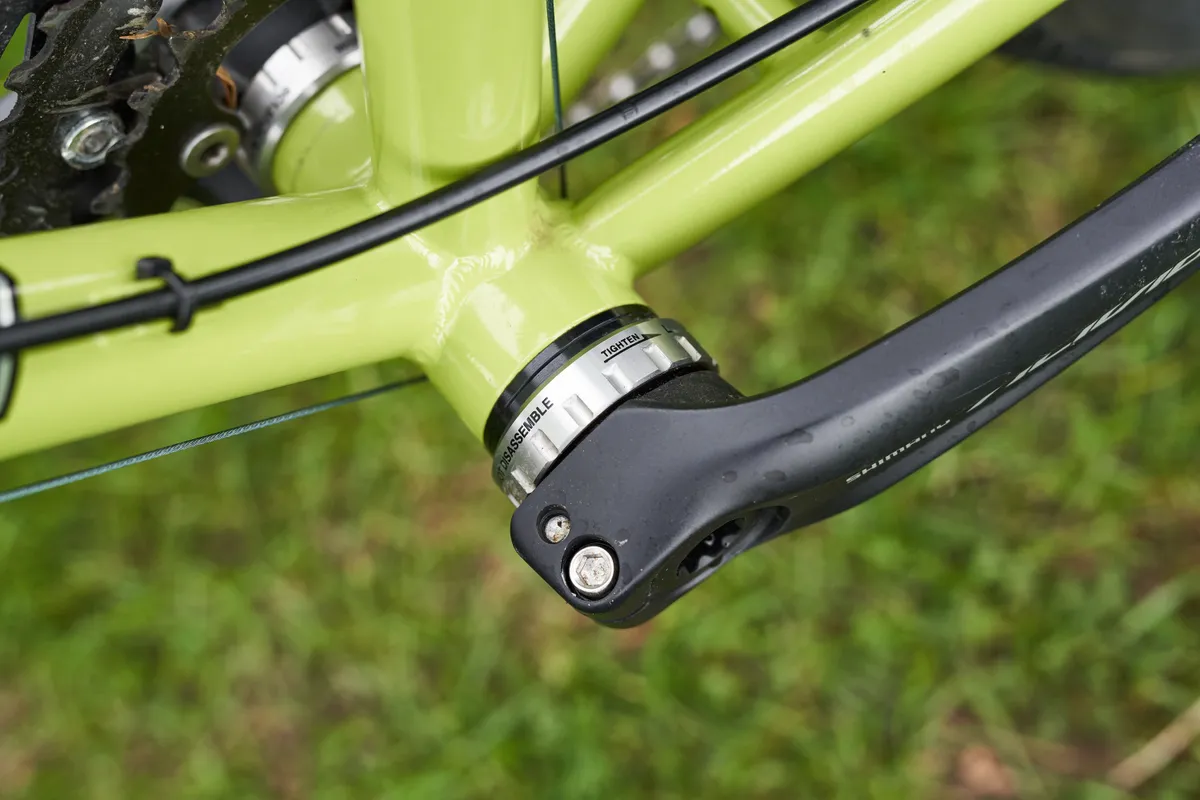Surly’s Disc Trucker is a touring bike from the American brand best known for its no-nonsense steel bikes.
The brand describes the latest incarnation of the Disc Trucker as a “pure-bred drop bar touring bike suitable for travelling anywhere in the world on mostly paved roads”. The frame has more mounting points than you’ll ever need and can carry pretty much anything you may want to carry on an extended tour.
The result? The steel frame at the heart of the bike is well-considered, but it contributes to a heavy overall weight of more than 13kg for the 56cm size I tested. While touring bikes are never going to be light, it does make for a lethargic ride unloaded and there are also some low points in its spec choices.
Surly Disc Trucker frame

You can tell you’re looking at a Surly, with the Disc Trucker’s silhouette faithful to the rest of the brand’s range.
The frame uses Surly’s proprietary ‘Natch’ 4130 Chromoly steel, with the main triangle double-butted and TIG-welded. The brand says this offers a good balance between comfort and stiffness, both loaded and unloaded.
The fork is made of the same 4130 Chromoly steel and is ‘ED’ (electrophoretic deposition) coated, which is an anti-corrosion treatment. It’s teeming with eyelets to mount cargo and features routing for a dynamo.
The disc brakes are of the flat-mount variety and 12mm thru-axles are used front and rear with a Mavic Speed-Release-esque system. This sees an open dropout on the non-driveside with a threaded, closed dropout on the driveside.

Once the axle has been loosened past its threaded section, the wheel can then drop out. This saves a couple of seconds, but there's not much in it compared to a standard thru-axle.
There are 11 sizes on offer (49cm through 62cm) and Surly says the Disc Trucker can fit riders from 5ft to 6ft 6in tall.
Once upon a time, frame sizes up to and including 56cm were offered with 26in wheels. Larger sizes, including a second 56cm option, come with bigger 700c wheels.
Surly has since stopped producing the 56cm, 26in wheel bike due to low demand.
It’s very rare to see a drop-bar bike with 26in wheels and while at one point, it may have been easier to acquire spares out in remote areas, it’s harder to argue that in 2022.
For the smaller sizes, Surly says it has stuck steadfastly with 26in wheels to achieve an optimal foot-to-front-wheel clearance. According to the brand, the smaller wheel achieves the clearance it feels is necessary and, during development, its testers preferred the handling the smaller wheels brought.
I am 5ft 11in and tested a size 56cm with 700c wheels.

Surly rates the tyre clearance up to 700c x 47mm, or 26x2.1in, with or without mudguards. The fork can accept up to 700c x 50mm or 26x2in tyres.
There are mounting points for up to three bottles in the main triangle – two inside and one on the underside of the down tube near the bottom bracket junction.
You can mount additional cargo or bottles on the fork and there are mounting points on the seatstays for pannier racks and/or mudguards.

Other neat details include a spoke holder on the non-driveside seatstay, should you be unlucky to be caught out, and room for a removable kickstand plate.
Surly even says the frame is Rohloff hub-gear compatible using the upper rack mount on the non-driveside dropout. The brand says the boss is sized to mimic an M6 bolt head and index perfectly with an OEM2 axle plate, with a chain tensioner necessary.
On the scales of truth, the test bike weighs in at 13.12kg.
Surly Disc Trucker geometry

The Surly Disc Trucker's geometry is, as you would expect, very relaxed. The brand says it carried out lots of ride testing before settling on the final geometry because “the bike needs to ride well both loaded and unloaded”.
On the size 56cm with 700c wheels tested, the stack is a very tall 613mm, which Surly has intentionally specced for a more upright and comfortable position.
This is coupled with a middle-of-the-road 387.5mm reach.
There are also long 450mm chainstays and a 1,051mm wheelbase for ride stability. Interestingly, the chainstays are shorter than the previous incarnation, which were a 460mm length. Surly says it shortened them by 10mm for “increased maneuverability”.

The shortened seat tube length of 560mm and slightly sloped top tube make for improved standover clearance, according to Surly.
The head tube angle is 72 degrees and the seat tube angle 73 degrees.
The head angle may seem on the steeper side, but Surly says “slacker head tube angles can ride quite well in most situations, but not particularly once the fork gets loaded up”.
That said, the smaller 26in-wheeled bikes get a slacker 70 to 71-degree head tube angle, so as to provide a more optimal fit.

On top of the tall head tube and headset spacers, Surly also specs its Truck Stop Bar. This is an aluminium handlebar with 30mm of rise, and its appearance is heavily reminiscent of Specialized’s Hover Bar.
For the most part, I generally got on with the fit, with the main exception of the skyscraping front-end height (and that’s for someone who’s not particularly flexible). I certainly didn’t experience any strain on my back.
To tackle this, I lowered the bars so there was 20mm of steerer tube protruding – I didn’t want to lower it any further because it’s never a wise idea to have an excess amount of steerer tube, which could act as a cookie-cutter into your sternum if you crash.
This size comes specced with 48cm handlebars, which I personally found overly wide, with my hands feeling splayed out. They measure 47.5cm across the tops and 53.5cm between the drops. However, some riders may prefer the wider bars, as they can offer increased control and stability.
It’s a good thing Surly ships the bike with lots of room for adjustment, so you can tailor it to your needs.
The 100mm stem length will appeal to people with most body proportions. I would have preferred a 172.5mm crank length over the 175mm specced, but it's a minor point.
| Frame | 42cm | 46cm | 50cm | 52cm | 54cm | 56cm (26in) | 56cm (700c) | 58cm | 60cm | 62cm | 64cm |
|---|---|---|---|---|---|---|---|---|---|---|---|
| Head tube angle (degrees) | 70 | 70 | 71 | 71 | 71 | 71 | 72 | 72 | 72 | 72 | 72 |
| Seat tube angle (degrees) | 75 | 74.5 | 74 | 73.5 | 73 | 73 | 73 | 72.5 | 72.5 | 72 | 72 |
| Effective top tube length (mm) | 500 | 515 | 530 | 545 | 560 | 575 | 575 | 590 | 605 | 620 | 635 |
| Head tube length (mm) | 125 | 130 | 170 | 185 | 205 | 225 | 175 | 195 | 215 | 235 | 250 |
| Seat tube length (mm) | 420 | 460 | 500 | 520 | 540 | 560 | 560 | 580 | 600 | 620 | 640 |
| Chainstay length (mm) | 450 | 450 | 450 | 450 | 450 | 450 | 450 | 450 | 450 | 450 | 450 |
| Wheelbase (mm) | 1,026 | 1,037 | 1,040 | 1,050 | 1,061 | 1,076 | 1,051 | 1,060 | 1,076 | 1,084 | 1,090 |
| Reach (mm) | 362 | 371 | 369 | 374.5 | 378 | 387.5 | 387.5 | 391 | 400 | 402 | 412.5 |
| Stack (mm) | 515 | 520 | 561 | 575.5 | 594.5 | 613 | 613 | 632 | 651.5 | 670.5 | 685 |
| Stem length (mm) | 70 | 70 | 70 | 90 | 100 | 110 | 100 | 100 | 110 | 120 | 120 |
| Handlebar width (cm) | 42 | 42 | 42 | 45 | 45 | 48 | 48 | 48 | 48 | 48 | 48 |
| Crank length (mm) | 165 | 165 | 170 | 170 | 170 | 175 | 175 | 175 | 175 | 175 | 175 |
Surly Disc Trucker ride impressions

I tested the bike for a month on a mixture of commutes, and shorter and longer rides, with the bike both loaded and unloaded. Testing conditions ranged from dry road riding to wet and very boggy conditions.
I also took the Disc Trucker on some towpaths, gravel and fields, thrown in with extended slices of muddy and rooty singletrack here and there to get a feel for its limitations.
Unloaded, I found the bike offers a lethargic ride and doesn't dampen vibrations as smoothly as other steel frames, likely because it's made of thicker-gauge tubes to carry the load. That said, it doesn’t beat you up and I ended all of my rides without much, if any, discomfort.
However, it’s a surprisingly different story once you’ve loaded the bike with bikepacking bags – when laden, the Disc Trucker comes to life.
Despite being very upright, the Disc Trucker offers a reasonably comfortable ride on most surfaces. The front end transmits more vibrations than the rear.
It's a similar story with the forks, which also offer a better ride quality when loaded. On the road, you can certainly feel some feedback from any ruts or potholes, but it’s not overly harsh.
I found the steel frame really came into its own when heading off-road, where the material really seemed to come alive and softened rooty and rocky surfaces delightfully. It definitely put a giddy smile on my face.
Despite being billed predominantly as a road bike, the Disc Trucker is more than suited to heading off the beaten track, so you won’t need to worry if the road suddenly comes to an abrupt halt during a tour.

That said, the clearance between the front tyre and crown of the fork is small at approximately 12mm. There was one instance in testing where this area clogged up with mud – a natural occurrence in tough conditions when clearance is tight.
When you’re on the gas or descending, the Disc Trucker feels assured, particularly when riding in a straight line.
Unfortunately, there are two aspects I believe hold the Disc Trucker back from being a great all-rounder.
The bike is noticeably slow to steer through corners. While this is to be expected compared to a typical road bike, I found the bike difficult to handle on twisty road descents or blind corners, where I was unsure if there may be a rider heading in the opposite direction to avoid.
Secondly, whenever the gradient even begins to slope upwards, the Disc Trucker is sluggish. Even on roads I wouldn’t classify as hills, it made them seem more like Alpine challenges and scaling them became a chore.
I would put both of these pitfalls down to a combination of the 48cm-wide handlebars, high-volume 700c x 41mm tyres and the weight of the bike.
Surly gives a ground trail figure of 68.68mm, which is higher than an endurance road bike or gravel bike.
The high trail will be of benefit when fully loaded, but for those looking to replicate the feel of their road or gravel bike, this explains why the Surly feels noticeably slower to handle.
Despite my reservations, it's important to remember that a touring bike will generally have slower steering and won't scale climbs as fast as a conventional road or gravel bike.
Surly Disc Trucker other details

The paint scheme on the Disc Trucker is interesting – it’s called 'Pea Lime Soup'. It may not sound very appetising, but I liked it in the flesh. A more muted 'Hi-Viz Black' is also available if it’s not your cup of tea.
The cable routing is fully external, with the front brake cable routed down the back of the fork leg. The rear cable is fixed to the inside of the down tube and top of the non-driveside chainstay via zip ties. This should make for welcome relief for mechanics, the Disc Trucker proving an outlier in a world of integration.
That said, I’d be worried about the cables abrading on the paint. Surly sticks some patches of clear frame protection on the head tube where the cables meet the frame, but there’s nothing where the rear brake cable briefly contacts the non-driveside face of the seat tube.
You may also want to add some protection to the inside face of the down tube in case the cable rattles and slaps on the paint.
The frame uses a dependable 68mm BSA threaded bottom bracket, which was creak-free throughout testing.
Surly Disc Trucker groupset

Surly has specced a mix of Shimano Sora and Alivio components with a triple chainring.
Sora is Shimano’s second groupset from the bottom in its road hierarchy, with nine speeds. Alivio is third up the mountain bike food chain, sitting above Altus and Acera.
The drivetrain is all from the Japanese brand, with the exception of the chain, which is from KMC. However, our test bike came with a Gusset 9-speed chain instead.
The Sora shifters use the same shape as Shimano’s cable-actuated 11-speed groupsets, before the 12-speed facelift, and other than the heavier-lever blade, you’d be hard-pressed to tell you’re riding Sora if you were blindfolded. It’s a great example of trickle-down technology.
The shifting quality is mostly very good and Surly has been wise to spec quality Jagwire cables. The Alivio M4000 rear derailleur doesn’t miss a beat, although the Sora R3030 front derailleur is best treated with respect, because it can struggle being shifted under load.

The gear ratios on the Alivio triple crankset are 48/36/26 and the Alivio cassette specced is an 11-34 – this combination will cover most bases and get you up a wall when climbing, even if, as I’ve already discussed, it’s not the fastest bike to climb on.
Importantly, when touring and laden with heavy bikepacking bags, you can never have a low enough gear.
Surly says the Disc Trucker can accept up to a 56/47/33 triple crankset, 50/34 double or a 47t single ring if you want to play about with the gearing.
Speccing a triple groupset means you do get a lot of duplicate gears and the drivetrain is more sensitive to cross-chaining (compared to a 2x drivetrain), but it does allow you to achieve a very low gear for climbing, so it's horses for courses.

TRP supplies the mechanical disc brakes with its Spyre model. This features a dual-piston design caliper, rather than a single-piston caliper, which sees one moving disc brake pad and one static pad.
Mechanical disc brakes have their limitations versus hydraulic brakes, but these were infinitely better than the C550s I tested on the State Undefeated recently. That said, the brake pads rattled inside the caliper, despite the pad retaining bolt securing them, which was deeply annoying.

The Jagwire CEX housing makes a positive difference in improving braking feel and there was even a hint of modulation with these brakes. However, like all mechanical disc brakes, they lack power when stopping quickly and despite many touring cyclists advocating their easier use on a tour, hydraulic systems offer significant performance benefits.
While I can understand the rationale behind speccing mechanical disc brakes on a touring bike, when you consider the overall build, the groupset choice feels a little stingy.
While it's not a like-for-like comparison, bikes such as the Trek Domane SL4 or Canyon Endurace AL 6 manage to squeeze in Shimano’s Tiagra groupset (which features hydraulic disc brakes) for a similar price. Tiagra also bumps the drivetrain up to 10-speed.
It's not a deal breaker but, overall, the build doesn't present great value for money.
Surly Disc Trucker wheels and finishing kit

Alexrims Adventure 2 rims are specced, laced by 36 spokes to Novatec hubs. The 36-spoke count is an inspired touring wheel choice and even if you are unlucky enough to break a spoke, the wheel shouldn’t go out of true.
The downside is, they’re very heavy. I weighed the front wheel in at 1,110g and the rear at 1,240g, resulting in a combined weight of 2,350g. While touring wheels will generally be heavier than more performance options, they still often come in at under 2,000g.

I wasn’t a fan of Surly’s own-brand ExtraTerrestrial tyres, specced in a 700 x 41mm width. The tyre measured 43.2mm on the front and 42.4mm on the rear.
Surly says the tyre provides “dependable handling and traction”. I found them to be adequate riding in a straight line on the road, but they make for an unnerving experience at times on corners because you can feel them squirm and lack grip.
Despite Surly saying otherwise, I found the tyres to grip better on light gravel, although they’re limited on anything hard-pack or mud. They’re not brilliant at cornering off-road either.
They’re also weighty at 680g each. For reference, after some initial experimenting, I settled on running them at around 37psi for my current 74kg weight, with their maximum pressure listed as 60psi.
For road touring, you’d be better served with perhaps a narrower 32 to 35mm tyre, or one of the best gravel tyres if most of your riding is on light gravel.
As I mentioned earlier, do bear in mind there isn’t a great deal of clearance at the fork crown.

The rims are tubeless-ready, but the bike arrives with inner tubes specced. This isn’t a huge disadvantage because you can quickly ditch those tyres without having to get sealant on yourself and spec some better tubeless tyres, if you wish.
A surprising but very welcome spec choice is Cane Creek’s 40-series headset, accommodating a 1-1/8in steerer – from past experience, it should be dependable.
The handlebars are wrapped with generic black cork bar tape, which is always a good choice. It’s easy to wrap, offers bucket loads of tactile comfort and doesn’t cost the earth.

Promax supplies the unremarkable aluminium stem and seatpost. If you’re after more comfort and you’re not planning on mounting anything to it, I’d recommend upgrading to a carbon seatpost to eke out additional compliance.
Sitting atop the Promax seatpost is a WTB Volt saddle, which was reasonably comfortable, although a little too padded for my taste. It wouldn’t be my first choice, but I didn’t see a reason to swap it out in testing.
What are the Surly Disc Trucker's competitors?
At $2,049, the Surly Disc Trucker doesn't represent the best value for money.
Although Genesis' Tour De Fer 30 is more expensive at £2,199, it features a full Shimano Tiagra 3x10 groupset, front and rear racking and a Shimano dynamo hub.
Trek's 520 could also be worthy of consideration at £1,650. It jumps down to an aluminium frame but retains the Sora / Alivio groupset specced on the Surly, and also includes front and rear racking.
Surly Disc Trucker bottom line

The Surly Disc Trucker will appeal most to touring cyclists who don’t want any surprises in terms of the geometry, triple drivetrain and sturdy wheels.
The steel frame is a quality item, and I found it performed best when fully loaded (its primary usage case).
The Shimano Sora / Alivio blended drivetrain is solid, as is the sturdy wheelset, but neither represent particularly great value for money with the Disc Trucker’s asking price.
That said, despite a workmanlike spec, it’s all generally dependable and durable, with some unexpected high points such as the Jagwire cables, Cane Creek headset and threaded bottom bracket.
If you know you won’t be packing to the gills, an adventure or gravel bike with the relevant mounting points would likely serve you better and offer a more visceral riding experience, if that’s what you’re after.
However, if you’re going to be loading cargo in excess of 40kg and don’t mind the heavier weight and going at a more sedate pace on the climbs, Surly’s Disc Trucker is definitely worth consideration. That's especially true if you already have a second bike for riding unloaded.
Product
| Brand | surly |
| Price | 2400.00 GBP,2049.00 USD |
| Weight | 13.1200, KILOGRAM (56) - |
Features
| Fork | 4130 Chromoly, Natch tubing, double-butted tapered fork blades, brazed lugs, ED coated |
| br_stem | Promax alloy, 31.8mm |
| br_chain | KMC X9, 9-speed |
| br_frame | 4130 Chromoly, Natch tubing, double-butted main triangle, TIG welded, ED coated |
| Tyres | Surly ExtraTerrestrial 700x41 |
| br_brakes | TRP Spyre C, 160mm rotors front and rear |
| br_cranks | Shimano Alivio 48/36/26 |
| br_saddle | WTB Volt Sport |
| br_wheels | Alex Adventurer 2 rim, Novatec hubs, 36 spokes, 12x100mm thru-axle (F), 12x142mm thru-axle (R) |
| br_headset | Cane Creek 40, 1 1/8in |
| br_shifter | Shimano Sora R3000 |
| br_cassette | Shimano Alivio, 11-34t, 9 speed |
| br_seatpost | Promax alloy, 27.2mm |
| br_gripsTape | Black cork |
| br_handlebar | Surly Truck Stop Bar |
| br_bottomBracket | Shimano BB-RS500, 68mm Threaded |
| br_availableSizes | 42cm, 46cm, 50cm, 52cm, 54cm, 56cm (26in), 56cm (700c), 58cm, 60cm, 62cm, 64cm |
| br_rearDerailleur | Shimano Alivio M4000 SGS |
| br_frontDerailleur | Shimano Sora ST-R3030 |
